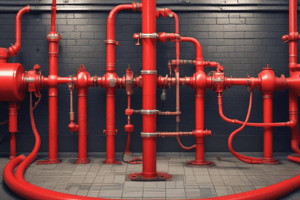Podcast
Questions and Answers
What is a critical key to consider when initiating a fire attack from a standpipe?
What is a critical key to consider when initiating a fire attack from a standpipe?
- Ensuring all elevators are functional
- Checking for fire alarms in every unit
- Availability of fire extinguishers on each floor
- Ability to provide adequate water supply (correct)
When considering firefighting from a standpipe, what does NFPA 1710 recommend regarding water flow?
When considering firefighting from a standpipe, what does NFPA 1710 recommend regarding water flow?
- Flowing at least 50 GPM for residential buildings
- Limiting flow to ground-level outlets only
- Utilizing a single hose line regardless of building height
- Simultaneously flowing from standpipes on multiple floors (correct)
What reduces the effectiveness of stretching hose lines from standpipe connections to the fire location?
What reduces the effectiveness of stretching hose lines from standpipe connections to the fire location?
- Presence of smoke and heat in stairwells and hallways (correct)
- Efficiency of the standpipe system itself
- Condition of the hose lines used
- Distance of the fire from the nearest standpipe
What is crucial to ensure when using a malfunctioning building fire pump during a standpipe operation?
What is crucial to ensure when using a malfunctioning building fire pump during a standpipe operation?
Which device is important for managing the flow of water in standpipe systems during firefighting?
Which device is important for managing the flow of water in standpipe systems during firefighting?
What must be ensured when dealing with the pressure of water in a standpipe system?
What must be ensured when dealing with the pressure of water in a standpipe system?
Which strategy is essential if a building fire pump is malfunctioning during a fire attack?
Which strategy is essential if a building fire pump is malfunctioning during a fire attack?
What is a limiting factor when attacking a fire using standpipes in multi-story buildings?
What is a limiting factor when attacking a fire using standpipes in multi-story buildings?
What flow rate is necessary according to NFPA 1710 for initial fire attack from standpipes?
What flow rate is necessary according to NFPA 1710 for initial fire attack from standpipes?
What role do pressure-reducing and pressure-restricting appliances play in standpipe systems?
What role do pressure-reducing and pressure-restricting appliances play in standpipe systems?
Study Notes
Fire Attack from Standpipes
- Phoenix's growth leads to an increase in large buildings and multi-story constructions, necessitating effective fire suppression systems.
- Firefighting personnel need to understand essential equipment for executing fire attacks from standpipes.
- Building types include commercial and residential, spanning from single-story to over 40 stories.
- Standpipe firefighting requires consideration of building systems, size, layout, and complexity.
- Key considerations for standpipe fire attacks include:
Water Supply and Pressure
- Ensure adequate water supply using building fire systems or engine company pumps.
- Provide high pump discharge pressures to compensate for malfunctioning or inadequate building fire pumps.
- Tandem pumping and high-pressure supply hoses are vital for effective operations.
Hose and Nozzle Management
- Maintain sufficient water pressure to the highest and farthest standpipe outlet based on the hose and nozzle specifications.
- Determine and manage adequate flow rates at the nozzle as part of the firefighting strategy.
Flow Rates and Standards
- Follow NFPA 13E and NFPA 1710 guidelines for gallons per minute (GPM) during initial and subsequent firefighting efforts from standpipe connections.
- Ensure flow capabilities from standpipes on multiple floors are effectively managed and executed.
System Components and Functionality
- Understand pressure-reducing and pressure-restricting devices within standpipe systems and their impacts on firefighting efforts.
- Strategically stretch hose lines from standpipe connections to fire locations, considering limitations imposed by smoke and heat in stairwells and common areas.
Fire Attack from Standpipes
- Phoenix's growth leads to an increase in large buildings and multi-story constructions, necessitating effective fire suppression systems.
- Firefighting personnel need to understand essential equipment for executing fire attacks from standpipes.
- Building types include commercial and residential, spanning from single-story to over 40 stories.
- Standpipe firefighting requires consideration of building systems, size, layout, and complexity.
- Key considerations for standpipe fire attacks include:
Water Supply and Pressure
- Ensure adequate water supply using building fire systems or engine company pumps.
- Provide high pump discharge pressures to compensate for malfunctioning or inadequate building fire pumps.
- Tandem pumping and high-pressure supply hoses are vital for effective operations.
Hose and Nozzle Management
- Maintain sufficient water pressure to the highest and farthest standpipe outlet based on the hose and nozzle specifications.
- Determine and manage adequate flow rates at the nozzle as part of the firefighting strategy.
Flow Rates and Standards
- Follow NFPA 13E and NFPA 1710 guidelines for gallons per minute (GPM) during initial and subsequent firefighting efforts from standpipe connections.
- Ensure flow capabilities from standpipes on multiple floors are effectively managed and executed.
System Components and Functionality
- Understand pressure-reducing and pressure-restricting devices within standpipe systems and their impacts on firefighting efforts.
- Strategically stretch hose lines from standpipe connections to fire locations, considering limitations imposed by smoke and heat in stairwells and common areas.
Studying That Suits You
Use AI to generate personalized quizzes and flashcards to suit your learning preferences.
Description
Test your knowledge on effective fire suppression techniques using standpipes. This quiz covers essential equipment, water supply management, and hose and nozzle handling for firefighting in multi-story buildings. Understand the key considerations for executing successful fire attacks in various building types.



